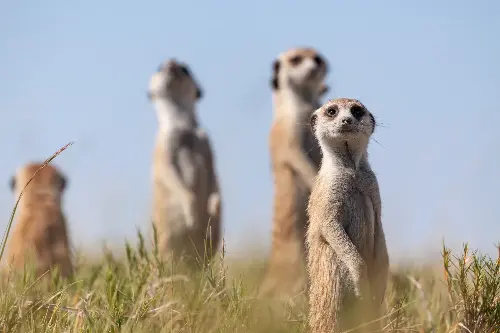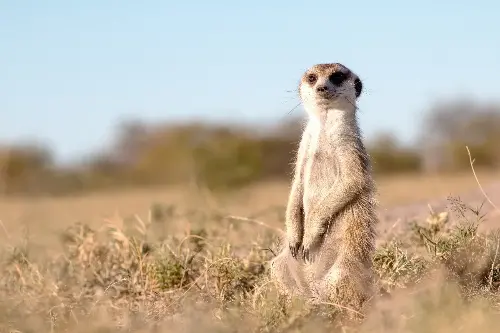Amidst the arid plains of the African savannah, there dwells a creature as endearing as it is fascinating. The meerkat, a small mammal belonging to the mongoose family, captivates observers with its charismatic behaviour and complex social structures. Let us embark on an insightful journey into the lives of these charming creatures and discover the vital roles they play in their native habitats.

Social Dynamics and Family Structures
Meerkats are quintessential social animals, living in groups called mobs or clans, which can number up to 50 individuals. These groups are incredibly coherent, with a strict hierarchy that dictates every aspect of meerkat life. Dominance is typically established by a matriarch, the highest-ranking female, and her partner, the alpha male.
Within this intricate social fabric, cooperation is key. Meerkats take turns performing essential duties, from foraging for food to keeping watch for predators. The survival of the clan hinges on each meerkat fulfilling its role with dedication, whether that role is as a sentry or as a caregiver for the group's pups.
The Sentry: A Meerkat's Guard Duty
Perhaps the most intriguing of these roles is that of the sentry. Stationed at the highest point available, a meerkat on guard duty sacrifices its time to eat or rest to ensure the group's safety. With sharp eyes, the sentry scans the horizon for threats such as eagles, jackals, or hyenas. At the slightest sign of danger, a complex system of vocal alarms goes into effect, prompting the clan to swiftly seek shelter in their burrows.
Engineering Experts: The Burrow Builders
The burrows are marvels of meerkat engineering. Extensive underground networks with multiple entrances and exits provide safe havens from predators and harsh weather conditions. These living quarters are a testament to the meerkats' teamwork and digging prowess, which sees them shifting several times their body weight in sand.
Remarkably, these burrows also contribute to the savannah's ecosystem. Abandoned meerkat homes can become shelters for other animals or aid in aerating the soil, which promotes plant growth and water absorption.

Pup Rearing and Babysitting Duties
When it comes to raising their young, meerkats display a collective approach. All members of the mob participate in the upbringing of the pups, from babysitting to teaching them to forage and hunt. This altruistic behaviour ensures that even if a parent falls prey to the harsh realities of the savannah, the offspring have a support system to fall back on.
The intricacies of pup care also extend to social learning. Young meerkats observe and mimic the actions of adults, gaining life-saving skills in the process. Through this close-knit communal living, meerkat pups learn the values of unity and cooperation from an early age.
Foraging: A Meerkat’s Daily Hunt
Life in the savannah demands resourcefulness, and meerkats rise to this challenge with their foraging strategies. Their diet is omnivorous, encompassing insects, lizards, snakes, scorpions, plants, and fruits. Adapted to their environment, meerkats have evolved to be immune to certain venoms, allowing them to tackle scorpions and some snakes without the mortal peril that these creatures typically pose.
Their foraging behaviour also contributes to the savannah’s ecology. By controlling the populations of insects and other small animals, meerkats help maintain a balance in their environment. This predatory role is essential in any ecosystem, ensuring that no one species becomes too dominant to the detriment of others.
Communication: A Language of Their Own
The complexity of meerkat communication is a subject of continued fascination. They employ a sophisticated array of sounds to convey specific messages – from the severity of a threat to the type of food discovered. Their vocalisations are not merely instinctual; they are indicative of a higher level of social intelligence that allows for complex interaction and bonding between clan members.

Adaptations to a Harsh Environment
Surviving in the harsh environment of the savannah necessitates unique adaptations. Meerkats have dark patches around their eyes, which reduce the glare of the sun and aid in their vigilant scanning of the surroundings. Their bodies are also built for temperature regulation, with the ability to conserve or dissipate heat as needed.
Moreover, meerkats have evolved a tolerance for the bite of certain venomous creatures, such as scorpions, which form a part of their diet. This remarkable adaptation showcases the resilience of these creatures and their ability to thrive under conditions that would be challenging for many other species.
Conservation and Human Impact
As alluring as they are, the lives of meerkats are not free from threat. Habitat loss due to human activities poses a risk to their continued survival. It is imperative that we understand the role these creatures play in the savannah and work towards their conservation. Responsible ecotourism and protected area management are key steps in ensuring that meerkats, and the delicate balance of their ecosystem, remain for generations to come.
In conclusion, meerkats are much more than the cute and curious animals entertaining us with their upright stances and alert expressions. They are integral components of their ecosystem, exhibiting a complex social structure that ensures their survival in a seemingly inhospitable landscape. From the diligent sentry to the team of babysitters, each meerkat plays a critical role in the collective wellbeing of their clan. As we delve into the remarkable lives of these charming creatures, we are reminded of the intricate connections that sustain the web of life on the African savannah.
